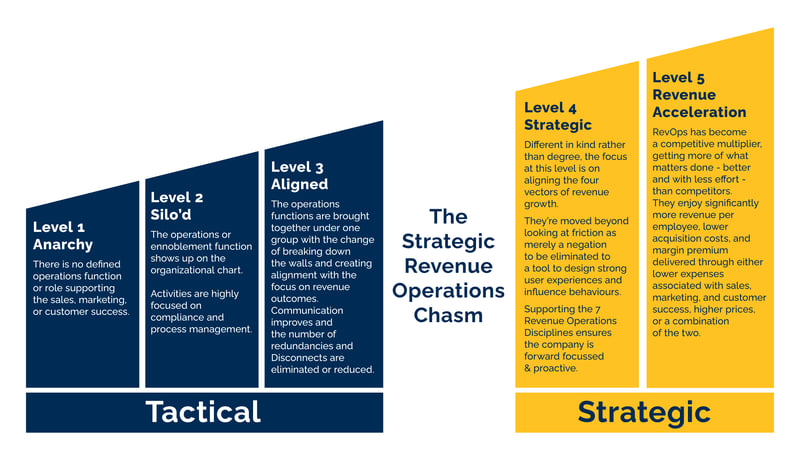 As my employees and clients know, I love to ask a lot of questions. My favorite is probably “Is the juice worth the squeeze?” In other words, “Is the effort worth it?”
As my employees and clients know, I love to ask a lot of questions. My favorite is probably “Is the juice worth the squeeze?” In other words, “Is the effort worth it?”
When we’re talking about RevOps helping close sales, the juice is definitely worth the squeeze.
RevOps’ biggest impact is creating a predictable and sustainable environment for more and better sales.
Notice I used two adjectives there: “more” and “better.” Companies often focus on “more” over “better,” which I’m using to mean high-quality sales. In fact, too much focus on “more” can backfire in lower profit and compressed margins.
When it comes to generating more and better sales, you get a lot more squeeze from strategic RevOps, rather than tactical. (I explain the difference here.)

So, for the purpose of this blog when I use the term “RevOps,” I’m actually talking about strategic RevOps. Without a strategic RevOps function, the tactical RevOps part is supportive at best and will not generate a meaningful difference.
Here are three ways strategic RevOps helps your company close more sales. RevOps works by:
1. Creating the right focal point
While RevOps doesn’t do it alone, its primary responsibility is to define and translate the company’s underlying go-to-market strategy. This ties back to the business’s economic model and elements related to the sales model and scoreboard, especially key metrics.
That decision is very important for the health of your sales pipeline, as is making adjustments when needed.
When salespeople are chasing the number of wins, degradation in the quality of your wins will likely follow. For example, if I'm selling a SaaS product and reward the highest number of sales, it’s almost a guarantee that the average sale value will go down.
The only thing worse than having the wrong focal point is having no clear focal point—because that means everyone is creating their own. Unfortunately, the vast majority of mid-market organizations lack a focal point. That means the goalposts shift depending on context.
For example, if a team has many wins at a low dollar value, they’ll tout the number of opportunities won—until the next quarter, when they have a high dollar value, but a low quantity. This issue is there’s no alignment or optimization, which results in bad friction and a lack of momentum and velocity.
In my opinion, you should never have more than five key initiatives—and out of those five, one should be the focal point initiative. But however many key initiatives you decide to have, you always need one focal point because that creates alignment, enablement, et cetera.
The focal point’s impact is invisible and huge; that’s why it’s important that it’s the right one.
The catch? It’s so invisible that no one will ever say “Gee, if we hadn't determined that focal point metric, we would never have made this sale.”
2. Separating the signal from the noise
When you're assessing RevOps’ contribution, you should be looking at it from a capacity or velocity perspective because it creates a structure and framework that enables both salespeople and the organization to filter out the extraneous. And like the focal point in the previous bullet, the effect of RevOps is also “invisible.” It flies under the radar.
For example, if you can eliminate some “invisible” work that allows reps to devote ten percent more time to sales, you’re getting more juice for the squeeze. If reps are spending too much time on bad opportunities because there’s no clear process for assessing deal quality, RevOps can fix that, but it’s hard to attribute a sale specifically to that improved process.
When RevOps is done right, sales reps are following playbooks; they aren’t even truly aware that they're doing things differently. That means structure, not individual judgment calls, is guiding their actions. In turn, that enables greater organizational performance and continuous improvement. It also allows your company to create and use data-driven insights.

As the old saying goes, “Do you know what the data tell us? Whatever you want it to tell us.” That’s because data on its own is anarchy. But data within a process, used to test a hypothesis, enables data-driven insights. If you have an opportunity, you can use an opportunity scoring rubric that allows sales reps to compare two—or for that matter, hundreds of—opportunities that are not necessarily similar. They can easily calculate where it makes sense to spend their time. They aren’t stressed out by trying to compare opportunities; they just focus on what makes sense.
3. Prioritizing and facilitating high-value activity
The Four Seasons philosophy is to automate the predictable so you can humanize the exceptional. This is exactly what a strong RevOps framework does. It frees up the salesperson because they don't have to spend so much time and so much brain power. remembering the questions, the information, and the next step.
RevOps not only gives reps more time to sell, it gives reps more bandwidth. It also takes the emotional volatility out of sales. Everyone, including me, has had a sales call take a sudden turn for the worse. RevOps means the sales rep has to think less about their internal process and can spend more time thinking about the factors and how to react. For example, when this happened to me far into the sales process, I initially started to panic, but then I stayed on course and realized that the situation had actually not changed at all.
A good CRM implementation does this. It helps keep the constraints in place so the rep can stay on course. It also allows them to focus on high-value activities as opposed to reacting to low-value ones.
Strategic RevOps offers a valuable framework that adds momentum and velocity to your sales organization. It does the “invisible” work that frees up time, energy, and mental bandwidth to give salespeople better opportunities. Because its effects fly under the radar, it’s often hard to quantify. But if your sales reps want to close more and better sales opportunities with less effort, RevOps is an invaluable tool.

 Doug Davidoff
Doug Davidoff
